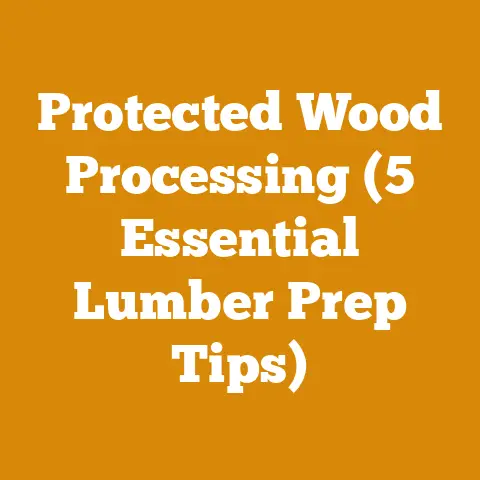Firewood Cord Measurements (5 Expert Tips You Need to Know)
Ah, the sight of neatly stacked firewood – a symphony of rustic hues and geometric precision! There’s something deeply satisfying about transforming raw logs into a winter’s worth of warmth.
Throughout my years of experience splitting logs and managing woodland, I’ve learned that knowing how to accurately measure and estimate firewood isn’t just about getting a fair price – it’s about understanding the true value of your hard work and the resources you’re managing. A “cord” seems simple enough, but there’s more to it than meets the eye.
Key Takeaways You’ll Learn:
- The official definition of a firewood cord and why it matters.
- How to accurately measure a full cord, face cord, and other common firewood quantities.
- Expert techniques for estimating firewood volume in loose piles and unconventional stacks.
- The impact of wood species, moisture content, and stacking density on the actual heat value you get from a cord of wood.
- Practical tips for negotiating fair prices when buying or selling firewood.
Let’s dive in and unlock the secrets of firewood cord measurements!
Decoding the Firewood Cord: A Beginner’s Guide
The term “cord” is thrown around a lot when buying and selling firewood, but what exactly is a cord? It’s more than just a pile of wood; it’s a standardized unit of measure. Understanding this standard is the first step to ensuring you get what you pay for (or charge fairly for what you sell).
What is a Cord of Firewood? The Legal Definition
A cord of firewood, by legal definition in the United States and Canada, is a precisely stacked pile of wood measuring 4 feet high, 4 feet wide, and 8 feet long. This equates to 128 cubic feet of total volume.
Important Considerations:
- This 128 cubic feet includes the wood and the air spaces between the pieces.
- The wood doesn’t have to be precisely 4 feet long. As long as the total volume is equivalent to a 4x4x8 foot stack, it’s considered a cord.
- The official definition is crucial for legal transactions and consumer protection.
The Anatomy of a Cord: Wood vs. Air
While a cord contains 128 cubic feet of space, the actual amount of wood is considerably less. The air gaps between the logs account for a significant portion of the total volume. This “void space” varies depending on the size and shape of the wood, as well as how tightly it’s stacked.
Data Point: Studies have shown that a loosely stacked cord can contain as little as 60-70 cubic feet of solid wood, while a tightly stacked cord might contain 80-90 cubic feet. This difference can significantly impact the amount of heat you get from a cord of wood.
Common Firewood Measurements: Beyond the Full Cord
While the full cord is the gold standard, you’ll often encounter other terms like “face cord,” “rick,” or “stove cord.” These terms are not legally defined and can vary significantly from seller to seller.
- Face Cord (or Rick): Typically refers to a stack of wood 4 feet high and 8 feet long, but with a width that varies. Often the length of the wood pieces themselves (e.g. 16 inches). This is where things get tricky! Since the width isn’t standardized, a face cord can be anywhere from 1/3 to 1/2 of a full cord. Always clarify the width before agreeing to a price.
- Other Terms: Terms like “truckload” or “pile” are even less precise. Avoid these terms whenever possible and insist on a measurement based on cubic feet.
Personal Anecdote: The Case of the Misleading Face Cord
I remember one time when I was just starting out, I ordered a “face cord” of oak from a local seller. The price seemed great, but when the wood arrived, it was significantly smaller than I expected. When I questioned the seller, he explained that his “face cord” was only 12 inches wide – barely a third of a full cord! This experience taught me a valuable lesson: always ask for specific dimensions and calculate the cubic footage before buying.
Measuring Firewood Like a Pro: Step-by-Step Guide
Now that you understand the definition of a cord and its variations, let’s get into the practical aspects of measuring firewood.
Measuring a Full Cord: The Gold Standard
The most accurate way to ensure you’re getting a full cord is to measure it yourself. Here’s how:
- Choose a Level Surface: Select a flat, even area to stack your wood. This will ensure accurate measurements.
- Build the Frame: Create a rectangular frame that is 4 feet high, 4 feet wide, and 8 feet long. You can use stakes and string, or build a temporary wooden frame.
- Stack Tightly: Stack the wood as tightly as possible within the frame. Minimize air gaps by alternating the direction of the logs and using smaller pieces to fill in spaces.
- Level the Top: Once the frame is full, level the top of the stack.
- Verify Dimensions: Double-check the height, width, and length to ensure they are accurate.
Pro Tip: Use a measuring tape with both feet and inches to ensure precise measurements.
Calculating Cubic Feet: The Math Behind the Measurement
If you can’t build a frame, you can still calculate the volume of a wood pile by measuring its dimensions and using a simple formula:
Volume (cubic feet) = Height (feet) x Width (feet) x Length (feet)
Example: A pile of wood that is 4 feet high, 6 feet wide, and 4 feet long has a volume of 4 x 6 x 4 = 96 cubic feet. This is less than a full cord (128 cubic feet).
Converting to Cords: To convert cubic feet to cords, divide the volume by 128:
Cords = Volume (cubic feet) / 128
Example: A pile of wood with a volume of 96 cubic feet is equal to 96 / 128 = 0.75 cords.
Measuring Irregular Stacks: Estimating with Accuracy
Sometimes, you’ll encounter firewood stacks that aren’t perfectly rectangular. In these cases, you’ll need to estimate the volume by taking multiple measurements and averaging them.
- Divide and Conquer: Divide the irregular stack into smaller, more manageable sections.
- Measure Each Section: Measure the height, width, and length of each section.
- Calculate Individual Volumes: Calculate the volume of each section using the formula above.
- Add the Volumes: Add the volumes of all the sections to get the total volume of the stack.
- Convert to Cords: Divide the total volume by 128 to get the equivalent number of cords.
Pro Tip: When measuring irregular stacks, be conservative with your estimates. It’s better to underestimate slightly than to overestimate and end up short.
Estimating Loose Firewood: The “Eyeball” Method
Estimating the volume of loose firewood (e.g., in a truck bed or a pile on the ground) is the most challenging. This requires experience and a good eye for volume. Here are some tips:
- Visualize a Cord: Imagine what a full cord would look like in the space.
- Break It Down: Divide the loose pile into smaller, more manageable sections.
- Estimate Each Section: Estimate the volume of each section in cubic feet.
- Add the Estimates: Add the estimates of all the sections to get the total volume.
- Convert to Cords: Divide the total volume by 128 to get the equivalent number of cords.
Expert Insight: “Estimating loose firewood is more of an art than a science,” says seasoned logger, John Peterson. “It takes years of experience to develop a good eye for volume. The key is to practice and compare your estimates with actual measurements.”
The Hidden Factors: Wood Species, Moisture, and Stacking
The volume of a cord is only one piece of the puzzle. The type of wood, its moisture content, and how tightly it’s stacked all significantly impact the amount of heat you’ll get.
Wood Species: BTU Content and Burn Time
Different wood species have different densities and BTU (British Thermal Unit) content. Hardwoods like oak, maple, and ash have a higher BTU content than softwoods like pine, fir, and spruce. This means they produce more heat per unit of volume and burn longer.
Data Point: According to the U.S. Department of Energy, a cord of seasoned oak can produce up to 24 million BTUs, while a cord of seasoned pine might only produce 15 million BTUs.
Practical Implication: When buying firewood, consider the species. You might pay more for hardwoods, but you’ll get more heat for your money.
Moisture Content: The Key to Efficient Burning
The moisture content of firewood is critical. Green wood (freshly cut) contains a high amount of moisture, which reduces its BTU content and makes it difficult to burn efficiently. Seasoned wood (dried) has a lower moisture content, which allows it to burn hotter and cleaner.
Data Point: Green wood can have a moisture content of 50% or higher, while seasoned wood should have a moisture content of 20% or less.
How to Season Firewood:
- Split the Wood: Splitting the wood increases its surface area, allowing it to dry faster.
- Stack Loosely: Stack the wood in a single row with air gaps between the pieces.
- Elevate the Stack: Elevate the stack off the ground using pallets or scrap wood.
- Cover the Top: Cover the top of the stack with a tarp to protect it from rain and snow.
- Allow Time to Dry: Allow the wood to dry for at least 6-12 months, depending on the species and climate.
Pro Tip: Use a moisture meter to check the moisture content of your firewood before burning it.
Stacking Density: Maximizing Heat Value
The way you stack your firewood can also impact its heat value. Tightly stacked wood will contain more solid wood per cord than loosely stacked wood. This means you’ll get more heat from a tightly stacked cord.
Best Stacking Practices:
- Stack in Rows: Stack the wood in neat, orderly rows.
- Alternate Directions: Alternate the direction of the logs to minimize air gaps.
- Use Smaller Pieces: Use smaller pieces to fill in spaces between larger logs.
- Tamp Down: Tamp down the stack periodically to settle the wood and reduce air gaps.
Expert Tips for Buying and Selling Firewood
Now that you’re armed with the knowledge of firewood cord measurements, let’s discuss some practical tips for buying and selling firewood.
Negotiating Fair Prices: Knowledge is Power
When buying or selling firewood, knowledge is power. Knowing the definition of a cord, how to measure it, and the factors that influence its heat value will help you negotiate fair prices.
Tips for Buyers:
- Ask for Specific Dimensions: Always ask for the specific dimensions of the wood pile.
- Calculate the Cubic Footage: Calculate the cubic footage and compare it to the price.
- Inquire About Wood Species: Ask about the species of wood and its BTU content.
- Check Moisture Content: Ask about the moisture content and how long the wood has been seasoned.
- Compare Prices: Compare prices from multiple sellers before making a purchase.
- Negotiate: Don’t be afraid to negotiate the price, especially if you’re buying a large quantity.
Tips for Sellers:
- Be Transparent: Be transparent about the dimensions, species, and moisture content of your firewood.
- Provide Accurate Measurements: Provide accurate measurements and be willing to let buyers verify them.
- Price Competitively: Price your firewood competitively based on its quality and the local market.
- Offer Discounts: Offer discounts for large quantities or repeat customers.
- Build Relationships: Build relationships with your customers by providing excellent service.
Avoiding Scams: Red Flags to Watch Out For
Unfortunately, there are some unscrupulous firewood sellers who try to take advantage of unsuspecting buyers. Here are some red flags to watch out for:
- Vague Descriptions: Sellers who use vague terms like “truckload” or “pile” without providing specific dimensions.
- Unusually Low Prices: Prices that seem too good to be true are often a sign of a scam.
- Refusal to Measure: Sellers who refuse to provide measurements or allow you to verify them.
- Green Wood: Sellers who try to sell green wood as seasoned wood.
- Hidden Debris: Sellers who hide debris or inferior wood in the center of the pile.
Case Study: A recent investigation by a consumer protection agency found that 30% of firewood sellers in one region were misrepresenting the quantity or quality of their firewood. Always do your due diligence before buying firewood.
Legal Considerations: Weights and Measures
In many jurisdictions, the sale of firewood is regulated by weights and measures laws. These laws require sellers to provide accurate measurements and disclose certain information to buyers.
Key Provisions:
- Accurate Measurement: Firewood must be sold by the cord or a fraction thereof.
- Disclosure Requirements: Sellers must disclose the species of wood and its moisture content.
- Receipt Requirements: Sellers must provide a receipt with the date, quantity, price, and seller information.
Pro Tip: Check your local weights and measures laws to ensure you’re complying with the regulations.
Optimizing Your Firewood Operation: Efficiency and Sustainability
Whether you’re a hobbyist or a professional, there are ways to optimize your firewood operation for efficiency and sustainability.
Streamlining the Cutting and Splitting Process
The cutting and splitting process can be time-consuming and labor-intensive. Here are some tips for streamlining the process:
- Invest in Quality Tools: Invest in a good chainsaw, splitting axe, and maul.
- Use a Log Splitter: If you process a lot of firewood, consider investing in a hydraulic log splitter.
- Sharpen Your Tools: Keep your chainsaw chain and axe blade sharp for efficient cutting and splitting.
- Work Safely: Wear appropriate safety gear, including eye protection, ear protection, and gloves.
- Organize Your Workspace: Organize your workspace to minimize wasted movement.
Data Point: Using a hydraulic log splitter can increase firewood processing efficiency by up to 50%.
Sustainable Forestry Practices: Protecting Our Resources
Firewood is a renewable resource, but it’s important to manage our forests sustainably to ensure they remain healthy and productive for future generations.
Sustainable Practices:
- Harvest Selectively: Harvest trees selectively, leaving the healthiest trees to grow.
- Replant Trees: Replant trees after harvesting to ensure the forest regenerates.
- Protect Water Quality: Protect streams and rivers from erosion and pollution.
- Control Invasive Species: Control invasive species that can harm the forest.
- Support Responsible Forestry: Support responsible forestry practices by buying firewood from certified sustainable sources.
Expert Quote: “Sustainable forestry is not just about protecting the environment; it’s also about ensuring the long-term economic viability of the forest industry,” says forestry expert, Dr. Emily Carter.
Storing Firewood Properly: Preventing Rot and Decay
Proper storage is essential for preventing rot and decay. Here are some tips for storing firewood properly:
- Elevate the Stack: Elevate the stack off the ground using pallets or scrap wood.
- Cover the Top: Cover the top of the stack with a tarp to protect it from rain and snow.
- Provide Ventilation: Allow for good ventilation to prevent moisture buildup.
- Inspect Regularly: Inspect the stack regularly for signs of rot or decay.
- Rotate Your Stock: Rotate your stock, using the oldest wood first.
Conclusion: Mastering the Art of Firewood
Congratulations! You’ve now unlocked the secrets of firewood cord measurements and gained valuable insights into the world of wood processing. From understanding the legal definition of a cord to optimizing your firewood operation for efficiency and sustainability, you’re well-equipped to buy, sell, and manage firewood like a true expert.
Remember, the key to success is knowledge and attention to detail. Always ask for specific dimensions, calculate cubic footage, and consider the species, moisture content, and stacking density of your firewood. By following these tips, you’ll be able to ensure you’re getting a fair price and maximizing the heat value of your wood.
Now, go forth and put your newfound knowledge to the test! Whether you’re stocking up for winter or starting your own firewood business, you’re now ready to tackle the task with confidence and expertise. And who knows, maybe you’ll even find a little bit of satisfaction in the process – just like I do every time I see a neatly stacked cord of firewood, ready to warm a home and hearth. Happy burning!






